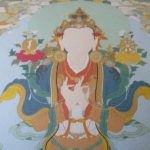
Interim Shambhala International Board Swears Religious Oath to Leader Accused of Sexual Assault
November 28, 2018
Senior Rigpa Students Ask for Sogyal Rinpoche to Be Reinstalled: Sources
December 10, 2018Yesterday, Toronto yoga and movement trainer Cecily Milne (@yogadetour) shared an Instagram post from the account of @ashtangatoronto. The post features a photo of teacher David Robson manipulating @lisaasana in an advanced backbend.
The post is captioned with a quote from meditation instructor Stephen Levine. The quote either compares or conflates the mental or psychological discomfort experienced in meditation with the physical discomfort of an extreme posture. The quote suggests that the best choice a student can make in relation to discomfort is to surrender.
“That surrender,” part of the Levine quote says, “that letting go of wanting anything to be other than it is right in the moment, is what frees us from hell.”
Robson is an Ashtanga yoga teacher, authorized to teach by Sharath Rangaswamy. Rangaswamy is the grandson of Pattabhi Jois, who has recently been outed for sexually assaulting female students over several decades. The revelations, along with the continued activism of survivors like Karen Rain, have prompted soul-searching throughout the Ashtanga world, and some steps towards accountability.
Milne’s commentary focuses on the message communicated by the image paired with the Levine quote. She makes reference to her own training with Robson at Ashtanga Yoga Centre of Toronto, where Robson claims to lead “one of the world’s largest Mysore programs outside of India.”
The 300+ comments under Milne’s post feature several reports of similar experiences at Ashtanga Yoga Center Toronto.
“Ughhh, I used to practice here too…” wrote one commenter. “I remember those adjustments. I remember the breath cues to relax into it…”. Another describes how the value of “surrender” in the environment led her to tears.
In a separate post, Milne described the “surge of anxiety” that preceded speaking out against the post, knowing that some might retaliate.
In response, Robson posted the following to his Facebook page. The statement interprets criticism of the notion that a student should physically surrender as a form of discrimination against the global Ashtanga community.
Soon after Robson’s response, his supporters began using the hashtags #bullying, #stopbullying, #troll, and #dontbeabully, referring to Milne.
Labelling criticism of a power imbalance as an attack is part of the DARVO mechanism, described by psychologist Jennifer Freyd. In the DARVO maneuver, a criticism or accusation is denied, the whistleblower attacked, and the roles of victim and aggressor are reversed.
The social media exchange comes as competencies for Ashtanga yoga teaching are being contested by a number of younger Ashtanga-affiliated teachers. This is a developing story.